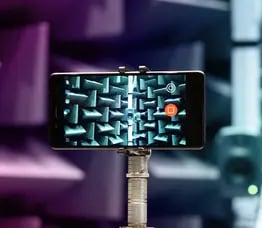Breaking through the noise: How next-gen AI is separating voices in real time

Have you ever been in a virtual meeting where multiple people speak at once, making it nearly impossible to follow the conversation? Or perhaps you've experienced the frustration of talking to your smart speaker while background chatter overwhelms your command? Recent advances in AI-based speech separation promise to change that.
In today's fast-paced, interconnected world, clear communication is more critical than ever. However, standard voice separation techniques have long struggled with one major hurdle: handling overlap in natural conversation. Traditional systems are often designed with a fixed number of speakers in mind and falter when confronted with real-life scenarios—where the number of speakers is unknown and can vary over time.
A new approach we developed in collaboration with Yuzhu Wang, Archontis Politis, and Tuomas Virtanen from Tampere University described in the paper "Attractor-Based Speech Separation of Multiple Utterances by Unknown Number of Speakers," takes a bold step forward. Using a clever mechanism called "attractors", this system identifies individual speakers in a crowded audio scene, dynamically estimating the number of speakers and isolating their voices, even as multiple utterances occur simultaneously.
What are attractors and why do they matter?
At the heart of this breakthrough is a concept the researchers call attractors. Imagine them as intelligent magnets in the feature space of a sound signal. These attractors latch onto specific characteristics of a speaker's voice, guiding the separation process by dynamically grouping parts of the audio that belong together. This method departs from older techniques that required predefined speaker counts. Instead, it actively adapts to the audio environment—whether two or three people (or more) are speaking—making it incredibly versatile.
The paper outlines how this attractor-based approach is integrated with an innovative architecture that combines local and global temporal modeling. In simpler terms, while the system pays attention to both short bursts of sounds (local patterns) and the overall context of the conversation (global patterns), it achieves remarkable performance in challenging conditions like noisy and reverberant environments. Tests showed that even when echoes and background noise tried to muddle the conversation, the system maintained clarity and accuracy.
Real-world applications: from virtual meetings to smart homes
The potential applications of this technology are vast. Two real-world examples where it could have an immediate impact include:
-
Virtual Meetings: Business meetings, webinars, and online classes often feature overlapping speech. By enabling clearer separation of voices, this technology can improve transcriptions, facilitate accurate note taking, and even enhance translation. Participants could enjoy a much more streamlined experience, where the system isolates and clarifies each speaker's contribution.
-
Smart Home Devices: As smart speakers and home assistants become more prevalent, ensuring they correctly understand your commands—even against the backdrop of daytime chatter—is critical. With this attractor-based approach, smart devices might soon be able to seamlessly separate multiple voices in the living room, making them far more responsive and accurate.
Beyond these examples, improved voice separation can foster better accessibility for those who rely on transcription services or assistive technologies. Imagine hearing-impaired individuals gaining access to clearer live captions during group discussions.
Innovation and future implications
The approach represents a significant innovation over conventional methods. Rather than restricting itself to scenarios with a fixed number of speakers, the system evolves with the complexity of real-world audio. It utilizes both Recurrent Neural Networks (RNN) and transformer-based attractors to dynamically detect speaker boundaries and count speakers accurately. Although rigorous experiments indicated that RNN-based attractors slightly outperformed the transformer variants in some setups, both methods dramatically pushed the envelope in dealing with overlapping voices.
Looking ahead, this technology has the promise of transforming how we interact with machines. As voice-driven applications continue to expand—from home automation and virtual assistants to more sophisticated human-computer interaction interfaces—the ability to "hear" and process individual voices accurately is paramount. We predict that this innovation could lead to:
- More Natural Human-Machine Dialogues: By effectively isolating voices, machines can interpret and respond to commands more naturally.
- Enhanced Virtual Collaboration: Improved voice separation will make online meetings more efficient and less chaotic, especially as remote work stays prevalent.
- Reliable Voice-Controlled Environments: With better separation comes improved accuracy in voice recognition, reducing errors and misunderstandings in smart devices.
A step toward clearer conversations
The work we present in this paper marks an important leap forward in speech processing technology. By leveraging the concept of attractors, the system adapts in real time to complex, overlapping audio streams—bringing us closer to seamless, natural interactions with digital devices. Even in settings filled with background noise or when several people speak simultaneously, the promise of clear, individual voice recognition is no longer a distant goal but an emerging reality.
What are your thoughts on this breakthrough? Do you see potential applications in your daily life, or perhaps unique challenges that might still need addressing? What is your perspective on how evolving voice separation technology might reshape communication in our increasingly digital world.
Join us to find out more at the INTERSPEECH 2025 conference in Rotterdam on August 19, where together with Yuzhu Wang from Tampere University, we will be presenting the paper Attractor-Based Speech Separation of Multiple Utterances by Unknown Number of Speakers – 08:30-10:30am.



